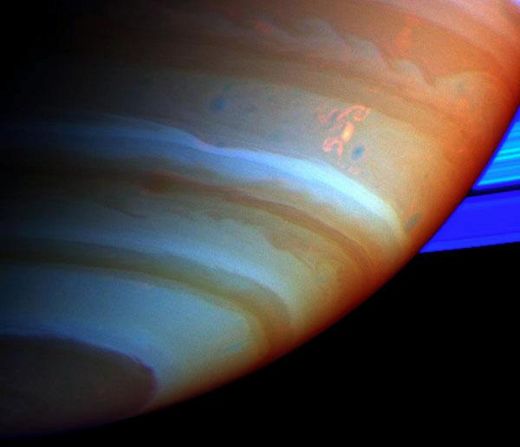
As a gas giant, Saturn's rotation has been historically difficult to measure. Its hazy atmospheric features shift with respect to each other and cannot be used to clock the spin rate of the planet's interior.
The most commonly cited figure for Saturn's rotation period - 10 hours, 39 minutes and 22.4 seconds - was derived in 1980 from Voyager observations of radio waves generated by solar radiation hitting the planet's atmosphere. Yet Cassini has returned a result almost 8 minutes longer, a difference that defies easy explanation.
"The knowledge of the rotation period is a very important ingredient when you try to model the interior of a planet like Saturn," says Giacomo Giampieri of NASA's Jet Propulsion Laboratory.
Reconcilable Differences?
Giampieri and colleagues examined data gathered over a 14-month period from Cassini's fluxgate magnetometer. The data revealed a small periodic signal in Saturn's magnetic field measuring 10 hours, 47 minutes.
If the signal is indeed tied to the rotation of the planet's solid core, as the Cassini team proposes, it is not clear how this can be reconciled with the earlier Voyager measurement.
"Nobody in their right mind could think the rotation rate of Saturn has changed so much in that period," says Donald Gurnett, principal investigator for the Cassini Radio and Plasma Wave Science instrument at the University of Iowa, US. Such a dramatic change in a planet of Saturn's size would require enormous energy. If such a force was being exerted, it would have long ago slowed the planet's rotation rate down to a snail's pace.
One possible explanation is that the electrically charged ionosphere surrounding Saturn is "slipping" relative to the planet's rotation. This ionosphere influences the shape of the magnetic field, so a change in the friction between the ionosphere and upper atmosphere, due perhaps to seasonal variations in solar illumination, might account for the difference between the Voyager and Cassini data.
Wobble Free
"It is absolutely not an instrumental error," says Gurnett, who was also principal investigator for the radio-sensing instrument on Voyager.
Previously scientists have used Jupiter's magnetic field to determine its rotation rate without ambiguity. Like Saturn, Jupiter's magnetic field is generated deep in the planet's interior and loops far out into space. But because Jupiter's field is tilted slightly, it wobbles as the planet rotates.
The wobble creates a strong periodic signal in Jupiter's magnetic field which is a reliable indicator of the planet's rotation speed. In contrast, Saturn's magnetic field is aligned with its rotational axis so there is no wobble effect.
The periodicity measured by Cassini is more likely to be caused by some kind of magnetic anomaly within Saturn, possibly tied to the nature of the planet's solid core.
Journal reference: Nature (vol 441, p 62)



But Saturn is not alone in being affected, the Sun is likewise behaving as if it was being externally acted upon.
One year from predicted Solar Maximum, and the Solar Activity is very low. The MSM is prompted to focus instead on a tornado phenomenon along a filament. That's not what the Sun should be primarily doing right now. It should be making big sunspots by the dozens and popping off massive flares a thousand times more powerful than it is currently doing.
So, it would appear, from what we currently know, that something is acting upon the Solar System as a whole. What could that be?